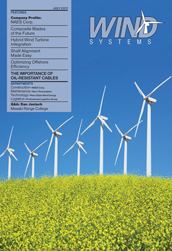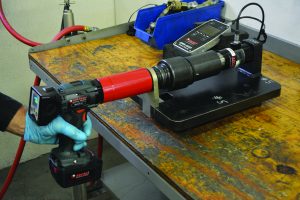When we speak of wind turbine maintenance we often refer to the scheduled, semi-annual, or annual service that involves such tasks as replacing filters, checking bolt torques, and other time-based activities found on the manufacturer’s checklist. But let’s say your technician returns from one of these scheduled maintenance activities with a new work request after he found a broken midsection ladder hatch hinge. The issue is noted on a service document, perhaps in a maintenance spreadsheet or CMMS application, and is tracked with the intent to schedule a time when the hinge can later be repaired. Since the issue does not impact actual production, the probability of a separate shutdown of the turbine just to repair this broken hinge is highly unlikely. The issue may in fact continue to remain unaddressed for a long period of time simply because of the priority placed on it, and may one day present a safety hazard that has an unfortunate outcome. While this isn’t a problem exclusive to the wind industry, it becomes more of a significant driver for managing ancillary maintenance of wind turbines because of the intermittent nature of wind turbine service work. The broken hinge in itself does not affect production, but repairing it would require additional downtime above what is planned for annual scheduled maintenance. Conversely, in other power generation technologies, the hinge could be repaired the very next day without impacting generation.
Determining how long an issue will remain on the work list is part of the strategy that each project operator must focus on when planning for scheduled maintenance. Time, money, and scope can each be compromised in efforts to return turbines quickly to service, but the consequences of not addressing serious issues in a timely manner can have later, distressing results to the bottom line. To emphasize this, the top 10 OSHA citations each year always include familiar issues to those of us who work in the wind industry. Fall protection, ladders, PPE, lock-out tag-out, training records, and hazard communication have consistently been on OSHA’s worst offenders list. While such findings may not be part of your reality today, having a solid program from the beginning of a project is the only way to assure you do not end up being a government statistic. Smaller maintenance issues might seem inconsequential to the greater goal of high availability, but they will need to be addressed at some point, and at a time before they become big maintenance issues or impact production.
The overall objective of the maintenance process is to reduce downtime, increase mean time between failures, prevent deterioration of equipment, and ensure that there are no incidents in the workplace due to mechanical failures. Smarter ways of managing the additional burden of compliance, addressing safety maintenance issues such as the broken hinge, and dealing with an expandable work list can be approached with best practices from other industries. Conventional power generation, for example, makes use of system or failure downtime to perform corrective and preventative maintenance work without further productive loss. This opportunity maintenance is performed on a machine or a facility when an unplanned opportunity exists during the period of performing planned maintenance activities to other machines or facilities. For a wind turbine, this same approach can be used when the system operator declares an outage, or when one component causes the turbine to fault and requires downtime to correct the failure and other corrective work can be completed during this downtime opportunity. The team must always be ready to take advantage of such opportunities, however, as this methodology requires the pre-planning of corrective maintenance tasks that can be performed during the unscheduled outage. Simply stated, the turbine is offline anyway, so we may as well replace that hinge.
Effectively planning opportunity maintenance and scheduled maintenance events while maximizing operational reliability is key to any planning and scheduling effort. Having a detailed list of prioritized issues, proper supply of materials that are available when needed, and an assessment of time and labor resources needed to accomplish each task are all variables in the scheduling equation. Using such tools as a “cause and effect matrix” or a Pick chart can help in the decision-making process. These exercises assist in organizing and categorizing each pending task, and will help determine which ones can be deferred until a scheduled maintenance and those that should be resolved at the next opportunity maintenance. When faced with multiple tasks on multiple turbines, they can be used to determine which ones will result in the greatest benefit.
To be proficient in managing your maintenance plan, it should be both a common practice and a team effort to focus on the sightline from maintenance reliability to business success. The entire team should understand the value of each downtime hour, how they create value, and what their specific contribution to the project’s overall performance is.




































